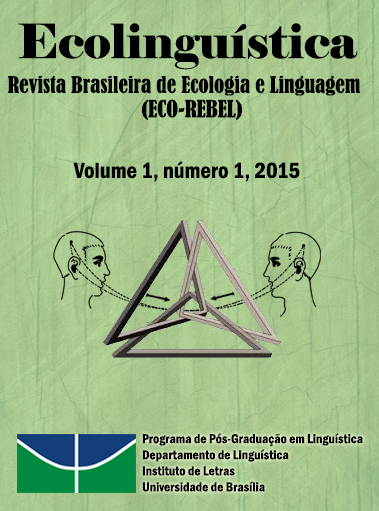Ecolinguística
A história de uma ideia verde para o estudo da linguagem
Keywords:
History of ecolinguistics; Anthropocentrism; language ecologies.Abstract
This article sketches the history of ecolinguistics, showing that its seed were already in authors such as Humboldt, Sapir and Whorf. The first investigator to associate ‘language’ and ‘ecology’ was Voegelin and collaborators. But, the first to suggest the use of the ecology metaphor in language studies was Einar Haugen, who was followed by William Makey, Norman Denison and Harald Haarmann. The article also shows that the term ‘ecolinguistics’ was first used in print in 1976, by Henri Gobard, and, a little later, by Kurt Salzinzer, in 1979, and by Claude Hagège in 1985. Further, three branches of ecolinguistics emerging (linguistic ecology, ecology of language, and ecology of languages). Among the other themes investigated by ecolinguistics we find anthropocentrism, sometimes hidden under euphemism. Ecolinguistics is relatively consolidated, and its future is promising, although ecolinguists must show how it can contribute to rescue endangered languages as well as how to do “transdiciplinary” researches. Which methods to use. In the end, Haugen’s proposal has been shown to be very fruitful.
Downloads
References
BOLINGER, D. Language ”“ the Loaded Weapon. The Use and Abuse of Language Today. Londres: Longman, 1980.
COUTO, H. H.. Ecolingüística: Estudo das relações entre língua e meio ambiente. Brasília: Thesaurus, 2007.
_______. Linguística, ecologia e ecolinguística. Contato de línguas. São Paulo: Contexto, 2009.
_______. Ecological approaches in Linguistics: a historical overview. Language and Sciences, v. 14, 2014, p. 122-128.
FILL, F. A. Ecolinguistics ”“ State of the Art 1998. In: Fill; Mühlhäusler (orgs.), 2001, p. 43-53. [originalmente publicado em 1998].
_______. The Language Impact. Evolution ”“ System ”“ Discourse. Londre: Equinox, 2010.
_______; Mühlhäusler, Peter (orgs.). The Ecolinguistics Reader. Language, Ecology and Environment. Londres: Continuum, 2001.
FISCHER, L. The Conservation of Conversation beyond English. In: FILL, F. A; TRAMPE, W; (orgs.) Colourful Green Ideas. Berna: Peter Lang, 2002, p. 59-76.
GRIN, F.; VAILLANCOURT, F. The Economics of Multilingualism: Overview of the Literature and Analytical Framework. In: GRABE, W. (org.). Multilingualism and multilingual communities. Cambridge: CUP, 1997 p. 43-65.
HAARMANN, H. Language in Ethnicity. A View of Basic Ecological Relations. Berlin, New York, Amsterdam: de Gruyter, 1986.
_______. Die Kleinsprachen der Welt. Existenzbedrohung und Überlebenschancen. Eine umfassende Dokumentation. Frankfurt/M: Peter Lang, 2001.
HAGÈGE, C. L’homme de paroles. Contribution linguistique aux sciences humaines. Paris: Arthème Fayard, 1985.
HALLIDAY, M. “New ways of meaning: the challenge to Applied Linguistics,” in: Fill / Mühlhäusler (orgs.). 2001 p. 175-202 [originalmente publicado em 1990]
HARRÉ, R.; BROCKMEIER, J.; MÜHLHÄUSLER, P. Greenspeak. A Study of Environmental Discourse. London: Routledge, 1999.
HAUGEN, E. The Ecology of Language. Essays by Einar Haugen. Ed. Anwar S. Dil. Stanford: Stanford U.P., 1972.
_______. The Ecology of Language. In: Fill; Mühlhäusler (orgs.), 2001, p. 57-66 [originalmente publicado em Haugen (1972: 325-339)].
MACKEY, W. F. The Ecology of Language Shift. In: Fill; Mühlhäusler (orgs.), 2001, p. 67-74. [originalmente publicado em 1980].
MAKKAI, A. “Die Welt als Bewusstsein und Paraphrase. Zur gesamtökologischen Fundierung des menschlichen Sprachverständnisses mit besonderer Berücksichtigung der Sprachphilosophie Wilhelm von Humboldts. In: Fill, Alwin (org.). Sprachökologie und Ökolinguistik, Tübingen:.Linguistic Ecology. Language change and linguistic imperialism in the Pacific Region. Londres, Nova York: Routledge, 1996.
_______. Humboldt, Whorf and the Roots of Ecolinguistics. LAUD working paper. Ser. A, 442. Essen: LAUD, 1998.
_______. Language of Environment ”“ Environment of Language. Londres: Battlebridge, 2003.
NETTLE, D. Explaining global patterns of language diversity. Journal of Anthropological Archaeology 17, 1998, p. 354-374.
_______; Romaine, Suzanne. Vanishing Voices. The Extinction of the World’s Languages. Oxford: OUP, 2000.
PHILLIPSON, R. English-Only Europe? Challenging Language Policy. London, New York: Routledge, 2003.
SALZINGER, K. Ecolinguistics: A radical behavior theory approach to language behavior. In: Aaronson, Doris; Rieber, Robert W. (orgs.) Psycholinguistic research: Implications and applications. Nova York: Erlbaum, 1979, p. 109-129.
SCHULTZ, B. Language and the Natural Environment. In: Fill, Alwin; Mühlhäusler, Peter (orgs.), 2001, p. 109-114 (publicado primeiro em 1992).
SUTHERLAND, W J.. Parallel extinction risk and global distribution of languages and species. Nature 423, 2003, p. 276-279 (Cartas a Nature, 15/03/2003).
VERHAGEN, F. Ecolinguistics: Context, Contours, Constraints, Challenges. Nova York: Sociological Energy Services International, 1991.
_______. Ecolinguistics: a Retrospect and a Prospect. In: Kettemann, B.; Marko, G. (orgs.). ECOnstructing Language, Nature and Society. The Ecolinguistic Project Revisited. Tübingen: Stauffenburg, 2000, p. 33-48.
VOEGELIN, Carl F.; Voegelin, Florence Marie. “Languages of the World. Native America Fascicle One,” Anthropological Linguistics v. 6, n. 6, 1964, p. 2-45.
(Este texto está também no livro O paradigma ecológico nas ciências da linguagem: Coletânea de ensaios clássicos e contemporâneos, Goiânia: Editora da UFG, 2015,organizado por Hildo H. do Couto, Elza K.N.N. do Couto, Gilberto P. de Araújo & Davi B. de Albuquerque).
Downloads
Published
How to Cite
Issue
Section
License
Authors who publish in this journal agree to the following terms:
Authors retain copyright and grant the journal the right of first publication. The work is simultaneously licensed under the Creative Commons Attribution License allowing the sharing of the work with acknowledgment of the authorship of the work and initial publication in this journal.
Authors are authorized to enter into additional contracts separately for non-exclusive distribution of the version of the work published in this journal (e.g., publishing in institutional repositories or as book chapters), with acknowledgment of authorship and initial publication in this journal.
Authors are allowed and encouraged to post and distribute their work online (e.g., in institutional repositories or on their personal page) at any point before or during the editorial process, as this can bring about productive revisions as well as increase impact.
Citation of published works (See The Effect of Free Access).



3.png)



